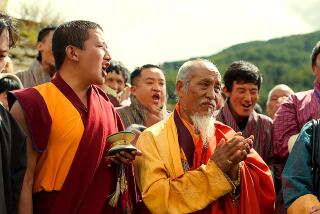The hunt for a special child
- Share via
“Unmistaken Child” does more than take you inside a closed culture in an almost unreachable part of the world. It bears witness to a strange and mysterious process, the search for the childhood reincarnation of a recently deceased and revered Tibetan master. Its privileged glimpse deep into unfamiliar spiritual territory has the strength of revelation.
This journey began for writer-director Nati Baratz in 2002, when he met a monk named Tenzin Zopa at the Kopan Monastery in Nepal and realized that the young man had been delegated by the Dalai Lama to find the reincarnation of the legendary Geshe Lama Konchog, who had died the year before at the age of 84.
Zopa was not chosen for his task by accident. For 21 years, since he was a boy of 7, he had on his own volition been the attendant of Geshe Lama Konchog, familiarly known as Geshe-la, a man revered for spending decades in solitary meditation in an isolated cave.
Though Geshe-la had been his whole life, Zopa feels deeply unworthy of the task of finding the unmistaken reincarnation of his master. He’s fearful, he says, of making a mistake because of not being enlightened enough himself to recognize the child in question.
Sensing a powerful story, filmmaker Baratz set about getting permission to film the process, first from Zopa and then from higher-ups in the hierarchical Tibetan Buddhist world. He finally got the OK, with the caveat that he couldn’t tell anyone, not even potential financiers, what he was doing until the process was over.
That permission, however, gained Baratz exceptional access to all aspects of this process, starting with communications with astrologers, whose tools include an Etch-A-Sketch type board. They point Zopa in the direction of the remote Tsum Valley between Nepal and Tibet where he and Geshe-la were born.
The camera follows Zopa as he goes from house to house in an area where residences can be miles apart, handing toffees to children and sensing whether they have any potential. His most emotional moment is when he revisits the structure where Geshe-la spent years meditating, which moves the disciple to tears.
Finally, using ancient tests similar to the ones seen in Martin Scorsese’s “Kundun,” such as the ability to recognize Geshe-la’s beads, a child is found. This discovery, however, is not the film’s culmination but just the beginning of its dramatic trajectory.
For how the situation plays out in human terms in a society that believes in reincarnation -- the way Westerners believe in gravity -- is fascinating. It is a subject that is poised to have serious political repercussions with the Chinese government and Tibetans in exile likely to clash over the identity of the next reincarnated Dalai Lama.
Given the intensity of Zopa’s devotion to Geshe-la, his interaction with the child, who comes to call the monk Big Uncle, is joyous and touching. Even more touching, though hardly joyous, is the dilemma of the boy’s parents, who have to decide whether to basically give him up for adoption, reincarnation or not, to the world of Buddhist monasteries.
Perhaps most interesting is observing how this totally self-possessed, self-contained youngster, one of the more remarkable children you will meet, reacts to being told he is both himself and another person.
“Unmistaken Child” is too sophisticated a film to try to convince you one way or another about the validity of reincarnation. But as director Baratz has said, after seeing the child in question, “I think we have to admit that they do know how to choose.” Indeed they do.
--
--
‘Unmistaken Child’
MPAA rating: Not rated
Running time: 1 hour, 42 minutes
Playing: At Laemmle’s Sunset 5 in West Hollywood; Laemmle’s Monica 4-Plex in Santa Monica
More to Read
Only good movies
Get the Indie Focus newsletter, Mark Olsen's weekly guide to the world of cinema.
You may occasionally receive promotional content from the Los Angeles Times.










